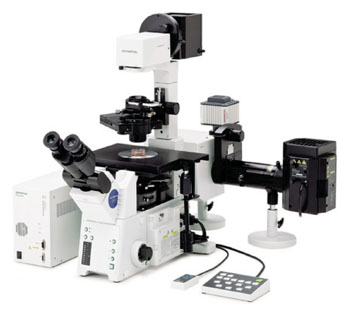Blood Biomarkers Diagnose Stroke Accurately
By LabMedica International staff writers
Posted on 23 Apr 2014
A new blood test is being developed that one day could rapidly confirm whether someone is having a stroke and what kind, will lead to faster diagnosis and treatment, which could mean the difference between life and death. Posted on 23 Apr 2014
A device has been constructed that can process whole blood and isolate genetic material for two potential stroke biomarkers within minutes, and by identifying more biomarkers could aid in diagnosis as the device can analyze a total of four biomarkers at the same time.

Image: The IX71- DSU Spinning Disk Confocal inverted microscope (Photo courtesy of Olympus America).
Scientists at the Louisiana State University (Baton Rouge, LA, USA) designed and tested the performance of a polymer microfluidic device that can affinity select multiple types of biological cells simultaneously with sufficient recovery and purity to allow for the expression profiling of messenger ribonucleic acid (mRNA) isolated from these cells.
The microfluidic device consisted of four independent selection beds with curvilinear channels that were 25 μm wide and 80 μm deep and were modified with antibodies targeting antigens specifically expressed by two different cell types. Bifurcated and Z-configured device geometries were evaluated for cell selection. Whole blood samples were obtained from anonymous healthy donors. To analyze the cells the scientists used flow cytometric analysis and evaluated carboxylic acid surface densities.
Cell characterization was performed by acquiring fluorescent images on an IX71-DSU Spinning Disk Confocal inverted microscope (Olympus America; Center Valley, PA, USA). Reverse transcription and polymerase chain reaction (PCR) of CD4+ T-cells and neutrophils was performed after they were isolated on a chip and lysed by infusing with lysis buffer. Reverse transcription (RT) was accomplished using a ProtoScript II First Strand cDNA Synthesis Kit (New England BioLabs; Ipswich, MA, USA).
The team demonstrated the affinity-based microfluidic system was capable of isolating highly pure subsets of leukocytes from whole blood. Processing 50 μL of whole blood in about three minutes provided sufficient genetic material for gene expression profiling. Special emphasis was placed on the fluid dynamics and design architecture of the device for T-cell and neutrophil isolation to obtain high purity leukocytes fractions using a single step. The isolation of two types of cells from whole blood was accomplished with purity of greater than 90%.
The expression of possible stroke biomarker genes from isolated T-cells and neutrophils, such as the calcium binding protein A9 (S100A9), the T cell receptor beta (TCRB), and the formyl peptide receptor 1 (FPR1), was evaluated using RT-PCR. The modification and isolation procedures can also be used to analyze other cell types as well where multiple subsets need to be investigated. The study was published online on March 20, 2014, in the journal Analytical Chemistry.
Related Links:
Louisiana State University
Olympus America
New England BioLabs













